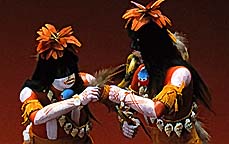The spirit of the invisible life forces of the Pueblo of North America. The kachinas, or kachinam, are impersonated by elaborately costumed masked male members of the tribes who visit Pueblo villages the first half of the year. In a variety of ceremonies, they dance, sing, bring gifts to the children, and sometimes administer public scoldings. Although not worshiped, kachinas are greatly revered, and one of their main purposes is to bring rain for the spring crops. The term kachina also applies to cottonwood dolls made by the Hopi and Zuni that are exquisitely carved and dressed like the dancers. Originally intended to instruct the children about the hundreds of kachina spirits, the finer carvings have become collector’s items. The name is also spelled katchina.
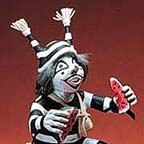 |
Koshari, Clown The Koshari Kachina is known by various names-Clown, Glutton, Hano Clown. The multiple names give some indication of his origin. Koshari or variants of them may be found in most of the pueblos in New Mexico, as well as in the Hopi Mesas. They are figures that are both sacred and profane. Their actions, while highly amusing, are not what the Hopi or anyone else would like to be caught doing in public. They are the ultimate example of overdoing everything they set about. Often pictured with a watermelons, this connotes gluttony. |
||
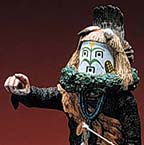 |
Navajo Night Chant Yeibichai This kachina is intended as a replica of the Navajo Talking God, the leader of the Yeibichai dancers who wear masks of the Yei and appear in the ninth and last night of the Navajo’s Nightway healing ceremony. The Hopi stage a Navajo Kachina Dance on First and Third Mesas, led by this kachina. The corn plant in the center of the mask signifies life and a prayer for a rich harvest. |
||
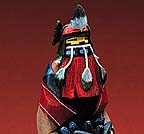 |
Blue Corn Maiden The Kachin’ Mana, or Kachina Maiden, is the most ubiquitous of all the women who appear with other kachinas. If she is carrying blue corn, she is known as the Blue Corn Maiden, similarly yellow corn, etc. She also changes her name to that of the kachina with whom she is dancing, although her appearance does not change. Her presence is a prayer for corn. |
||
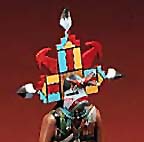 |
Palhik Mana or Butterfly Maiden The Palhik Mana or Butterfly Maiden, is one of the most popular kachinas in the Hopi carvers’ repertoire. This beautifully dressed figure is not really a kachina, but rather a woman’s dance personage. Women who appear in the Mamzrau Initiation Dance are called the Palhik’ Manas. They are never masked except on Third Mesa, although they all appear to be when carved as dolls. The carvings typically include an elaborate tableta including butterfly and corn symbols. |
||
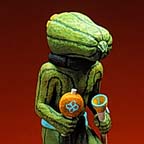 |
Squash Kachina Plants are of great importance to the Hopi, because of their dependence upon them for food. (Corn is the most important food, and most often used plant kachina.) The Patung Kachina, or Squash Kachina, is a chief kachina of wuya for the Pumpkin Clan. There are relatively few members of this clan left, and consequently their stories are not very well known. Although the Squash Kachina’s function as a wuya are unknown, he does appear as a runner on First Mesa. His effigy is a great favorite for collectors. |
||
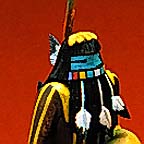 |
Long-Haired Kachina Angak’china, the Long-Haired Kachina, is a bringer of gentle rains and flowers. He is the Kokokshi of Zuni, and yet he appears in almost all of the pueblos from the Hopi to the Rio Grande. His songs are melodic and the dance a beautiful one to see in the springtime, and is a favorite of the Hopi. The dancers’ long hair worn loose down the back resembles the falling rain with the eagle breast plumes rising like clouds above it. These kachinas are occasionally used for the Niman Ceremony on First Mesa. Many varieties of this kachina exist: Barefoot, Bounding, Navajo, Tewa, Lightning, to name the most frequently carved. |
||
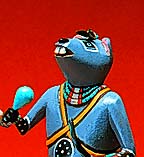 |
Mouse Doll The Mouse is not a dance figure at all, but rather the hero of a Second Mesa legend. A mouse undertook to rid the village of a pesky chickenhawk. This he did by taunting the hawk and eventually tricking him to dive into a stake and impale himself. The Warrior Mouse, as he is called, is not to be confused with Mickey Mouse, who has no Hopi roots at all. Hopi do not consider this doll a kachina, and most anthologies do not include him in their roster. |
||
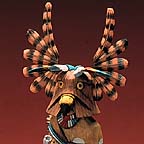 |
Great Horned Owl Kachina Mongwu, the Great Horned Owl Kachina, is a constant favorite of kachina carvers, and the ingenuity shown in making the heads of these dolls is to be marveled at. The kachina is a warrior who disciplines the clown when their behavior becomes too outrageous. Appears in Mixed Kachina Dance and in some ordinary dances. At First Mesa, he takes part in the Bean Dance and in the Water Serpent Ceremony. |
||
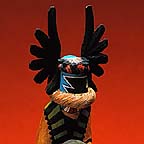 |
Crow Mother or Crow Bride Angwushahai-i, or Crow Bride, is a Third Mesa Kachina, with the “bride” probably coming because she talks or sings, and comes dressed entirely in white. On the other Mesas, she is Angwusnasomtaka, or Crow Mother, the mother of the Hu, or Whipper Kachinas, and is considered by many Hopi to also be the mother of all kachinas. She appears during the Powamu or Bean Dance on all three Mesas. During the Powamu, she supervises the initiation of the children into the Kachina Cult and carries the yucca whips with which they are struck by the Hu Kachinas. Later in the same ceremony, she leads other kachinas into the village bearing in her arms a basket of corn kernels and bean sprouts to symbolically start the new growing season properly. |
||
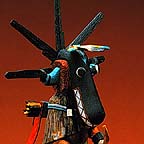 |
Black Nata-aska Ogre, White Wiharu Ogre Nata-aska, the Black Ogre, and Wiharu, the White Ogre, carry a saw (sometimes a knife) as well as a bow and arrows for hunting. Their outstanding feature is their long, flapping jaws, which they can clack most effectively. These Ogres accompany Soyoko on her trip to collect food from the children. As a means of discipline, children are told the ogres can swallow them whole, unless they are good little children. Anglos would call them the “boogymen.” |
||
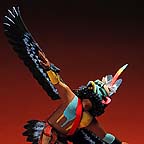 |
Eagle Kachina Kwahu, the Eagle Kachina, appears most often with Mudheads in the Kiva or Repeat Dances of early March. The dance is a conscious effort to duplicate the actions and motions of eagles and is a prayer for an increase of eagles. Eagles occupy a rather unique position among the Hopi, for they are treated as honored guests, and are given presents just as the Hopi children are. |
||
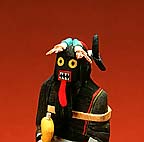 |
Warrior Maiden He’e’e, the Warrior Maiden Kachina, represents a warrior spirit. It is either a man dressed in women’s clothes or a woman using men’s equipment, depending on the mesa where one hears the story. At Second Mesa, the story goes: A young man changed clothes with his bride in a corn field and was only half-dressed with his hair up is a whorl on one side and loose on the other, and with his pants on under the dress when he saw his enemies approaching. (By custom, maidens wear their hair in whorls on each side of their head.) Grabbing his weapons, he fought them off until assistance arrived. At Oraibi, it is a young maiden having her hair put up who takes up her father’s weapons till help arrives. Despite the variation in the folktales, the kachina is a potent warrior, and during the Pachavu Ceremony, she leads a band of fearsome warrior kachinas to protect the procession. Because she is so potent, there are other guards who protect certain ceremonies from her dangerous presence. |
||
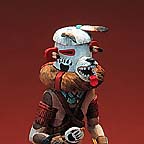 |
White Bear Kachina Hon, the Bear Kachina, is frequently distinguished only by color, such as white, black, blue, or yellow. All Bear Kachinas are believed to be very powerful and capable of curing bad illnesses. They are great warriors. Bear Kachinas appear most often in the Soyohim or Mixed Dances of springtime, or occasionally as side dancers for the Chakwaina Kachaina, a great warrior kachina. |
||
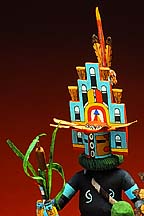 |
Hemis Kachina The Hopi have several borrowed kachinas, the Hemis Kachina, or Jemez Kachina, is one of them. Kachinas are borrowed from other puebloes because they appear particularly effective in bringing rain or in exercising their other attributes. The Hemis Kachina is most often used for the Niman or Home-Going Ceremony when the kachinas leave the Mesas for six months. It is one of the most appropriate kachinas for this farewell, as it is the first kachina to bring mature corn to the people, indicating that the corn crop is assured. |
||
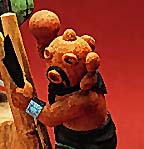 |
Mudhead Kachina Koyemsi, or Mudhead Kachina, is a multi-faceted clown borrowed from Zuni. They may appear as a chorus, and on First Mesa and possibly other villages their songs are in Zuni. During the rests in a dance, they may engage in games with the boys and girls in the audience. At other times, only a single Mudhead may appear as a drummer for a group. Should a dancer not have the proper mask or be late in arriving, he can easily become a Mudhead by donning that mask. These kachinas appear in almost every Hopi dance. |
||
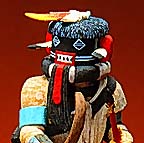 |
Left-Handed Hunter Kachina Siyangephoya, or Left-Handed [Hunter] Kachina, is said by some be be derived from the Hualapai Indians, but other Hopi attribute them to the Chemehuevi. He is left-handed because his gear is reversed, and to draw an arrow from the quiver, he must use his right hand rather than his left, as is normal. This kachina moves with strange bobbings and little mincing steps. Despite his odd behavior, he is supposed to be an excellent hunter. In carvings, he is usually shown with a rabbit at his feet. |
||
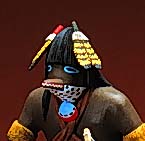 |
Mountain Lion Kachina Toho, or Mountain Lion Kachina, often accompanies such animals as the Deer or Antelope Kachinas when they appear in the Line Dances of spring. However, during the Pachavu or Tribal Initiation about every fourth year, Toho appears as a guard. Armed with yucca whips, he patrols the procession in company with He-e-e, Warrior Woman, and other warrior or guard kachinas. |
||
|
|||

